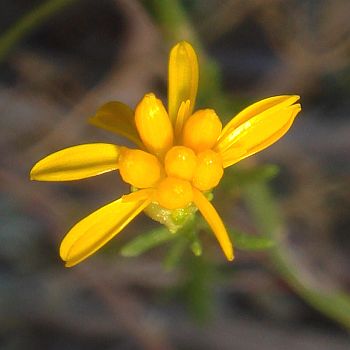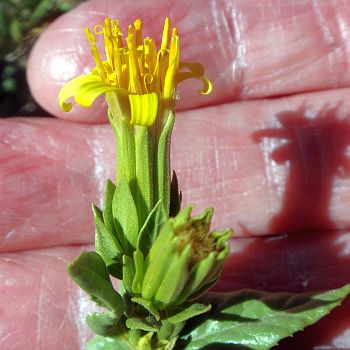Bloom Reports from the Anza-Borrego Desert: 2012-2013
 |  |
| Pictures taken on 2 January 2013 in Plum Canyon.
See also Pictures shown here on prior dates. | |
See Bloom Reports from the Anza-Borrego Desert for an introduction to this page, extensive general information (not specific to this year) about Annual Germination, Growth and Blooms, including what influences the duration and extent of the annual bloom, photo galleries, and links to other webpages giving information on Anza-Borrego Desert State Park Blooms.
Summary of Annual Germination, Growth and Blooms in 2012-2013
The 2012 summer monsoon was very active in the entire desert, and germinated monsoonal annuals nearly everywhere. However, the continuous 100° plus heat every single day in August and September 2012 ended the monsoonal bloom by the end of October 2012.
We are back to the expected flowers few until we get significant winter rain. As of 21 January 2013, the desert floor has only received 0.2 to 0.5 inches of rain since 1 September 2012, which isn't enough to germinate annuals except possibly along roadsides and other places with similar runoff. Higher elevations on the west side have gotten a bit more rain, enough to produce some germination.
Since annual germination normally occurs in late December or early January, it is definitely time to worry about whether there will be much of a wildflower season this year. February rains can germinate annuals, but unless rains continue to fall regularly after that, those February rains will only produce tiny annuals.
We have observed only scanty annual germination in Anza-Borrego Desert State Park so far, at its westernmost edge in the San Felipe Valley and Sentenac Canyon, and in widely-scattered parts of Henderson Canyon. In Henderson Canyon on 1/12/13, the main wash had scattered babies of whispering bells, Emmenanthe penduliflora, just producing their first true leaves. Shady spots under boulders in the upper canyon hold hundreds of plants of white fiesta flower, Pholistoma auritum var. arizonicum, also producing their first true leaves.
Farther west, Culp Valley now looks green from annual germination, but most germination is of two non-native species: redstem filaree, Erodium cicutarium, and red brome, Bromus madritensis ssp. rubens. We observed a few prickly poppies, Argemone munita, on 21 December 2012 in Shelter Valley, and a handful of white fiesta flowers, Pholistoma membranaceum, on 8 January 2013 in Sentenac Canyon. Mike Crouse found decent annual germination in one wash next to the Mexican border in the El Centro area in Imperial County on 18 December 2012.
Plants along the Montezuma Grade of S22 still mostly look like they do in late summer, completely dormant.
See also:
- Detailed Germination, Growth and Bloom Reports From Each Hike: 2012-2013.
- Pictures From Each Hike: 2012-2013.
- Number of Species and Plants in Bloom On Each Trip: 2012-2013.
- List of Species in Bloom On Each Trip, With Photographs: 2012-2013.
- Rainfall in 2012-2013.
Predictions for This Year
It is far too early to make any predictions for this year, other than to note that the monsoonal rainfall received nearly everywhere in the desert from late July to late September 2012 has given the perennials, shrubs and trees a good start in some places. Winter annuals, after they germinate from a winter rain, may benefit as well from stored moisture in the soil from the summer rains (where that moisture hasn't already been tapped by other roots).